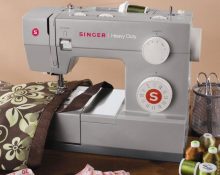
The first models of sewing machines almost completely repeated manual techniques. Over time, they were improved and supplemented with a number of details that made it possible to improve the work process.
What parts are there in a sewing machine?
Most modern models, regardless of their design, have a number of common parts:
- Sleeve. It contains a working rotating shaft.
- Platform. This is the name given to the surface that contains the bobbin thread control mechanism. Some models require the platform to be placed in a table recess.
- Drive belt. Transmits rotational motion to the flywheel.
- Bobbin mechanism. Includes thread tension regulator, cap and bobbin itself.
- Tensioners. They look like springs, the task of which is to push out the disks that clamp the thread. This helps keep it in constant tension.
- Rack. Moves fabric forward and backward. Located under the presser foot.
- Flywheel. It is called the working body of a sewing machine.It controls movement - either with a motor or manually.
- Head. Takes part in the formation of stitches.
- Heel. Located opposite the toe of the foot.
- Shuttle. Looks like a hook. Necessary for interlacing the bottom thread of the bobbin with the top thread.
- Knee lifter. Installed under the table of industrial models. Helps the operator raise and lower the presser foot.
- Electric motor. Powers the machine.
- Needle and needle bar. The first pulls the thread as it penetrates the fabric, the second holds it.
- Presser foot. An element that comes in many modifications. Necessary for attaching fabric to the needle plate.
- Lever arm. Loosens or tightens the thread when forming stitches.
In addition to the above parts, the sewing machine may contain other parts. This could be a pulley, thread guides, needle plate, thread tension discs.

@Assol.in.ua
Mechanism and principle of operation
How does it happen that a sewing machine creates a stitch through the fabric? This action occurs due to the fact that the needle interacts with the top thread of the shuttle and the thread of the bottom line. It looks like this:
- Drive unit starts the needle moving up and back. It pierces the fabric, which helps to form a loop underneath it. The shuttle grabs the thread loop and connects it to the thread that is wound on the bobbin. The thread take-up comes into play and lifts the upper threads. Tightening occurs, after which the device for pulling the fabric advances it to the length of the next stitch.
- The engine hidden under the body can be started manually or by connecting the machine to the mains. During operation, it can rotate three shafts: two side and one central.The first ones are responsible for advancing the fabric and the shuttle, the second one is connected by a connecting rod to the flywheel axis, which starts the needle bar. This synchronous interaction allows you to create even and uniform stitches. If at least one of the elements fails, a malfunction will occur.
Both new and old models of sewing machines, for the most part, do not wear out for a long time due to high-quality parts. Without repair, they can work from 5 to 10 years. The main thing is not to forget about lubricating oil and use the device strictly for its intended purpose.


 2
2





